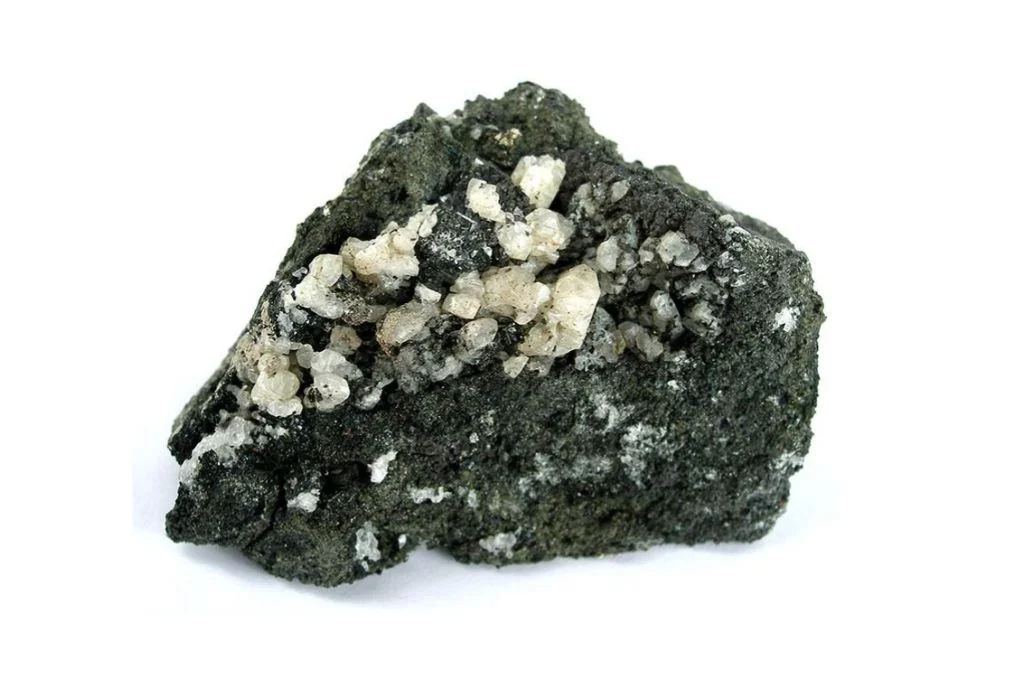Color and Appearance of Anorthite
Anorthite is a calcium-rich feldspar mineral that typically exhibits a white to grayish-white color. However, it can also occur in pale shades of pink, green, or blue, depending on trace impurities present during its formation. The crystal’s luster is typically vitreous to pearly, giving it a glassy or pearl-like appearance when light reflects off its surface.
Crystal Structure
Anorthite crystallizes in the triclinic system, forming tabular or prismatic crystals. These crystals often display a distinctive striated surface, with fine parallel grooves running along their faces. The mineral frequently occurs in twinned formations, particularly as albite twins, which can create a complex and visually striking appearance.
Physical Characteristics
With a Mohs hardness of 6 to 6.5, anorthite is relatively hard but can be scratched by quartz. It exhibits perfect cleavage in two directions, which intersect at nearly right angles, giving it a tendency to break into rectangular fragments. Anorthite has a specific gravity ranging from 2.74 to 2.76, making it slightly denser than many other common rock-forming minerals.
Unique Features
One of the most notable features of anorthite is its high calcium content, which distinguishes it from other feldspar minerals. This composition makes it an important indicator mineral in igneous petrology, particularly in the study of lunar rocks. Anorthite is also known for its occasional chatoyancy, a cat’s-eye effect that creates a silky, moving band of light across the surface of some specimens, enhancing its visual appeal and making it prized among collectors.
Historical and Cultural Significance of Anorthite
Anorthite, a calcium-rich feldspar mineral, has limited historical and cultural significance compared to more well-known gemstones. However, it has played a role in scientific research, particularly in planetary geology. Anorthite is a major component of lunar highlands, making it significant in our understanding of the Moon’s composition and formation.
Metaphysical Associations
In the realm of crystal healing and metaphysical practices, anorthite is believed to possess certain energetic properties. It is said to promote mental clarity and enhance one’s ability to process information. Some practitioners associate anorthite with improved memory and cognitive function. Additionally, it is thought to foster a sense of inner peace and emotional balance, helping individuals navigate challenging situations with greater ease.
Common Uses and Applications
Anorthite finds its primary use in scientific and industrial applications rather than in jewelry or decorative items. In the ceramics industry, anorthite is utilized as a raw material in the production of high-quality porcelain and other ceramic products. Its high calcium content contributes to the strength and durability of these materials. In geology, anorthite serves as an important indicator mineral, helping scientists understand the formation and composition of igneous rocks.
Benefits and Modern Applications
While not widely used in alternative healing practices, some believe that anorthite can provide various benefits. It is thought to aid in grounding and centering oneself, promoting a sense of stability and connection to the Earth. In modern applications, anorthite’s unique properties make it valuable in the study of extraterrestrial geology, particularly in understanding the composition of other planets and moons in our solar system. Its presence in lunar samples continues to provide insights into the Moon’s geological history and formation processes.

